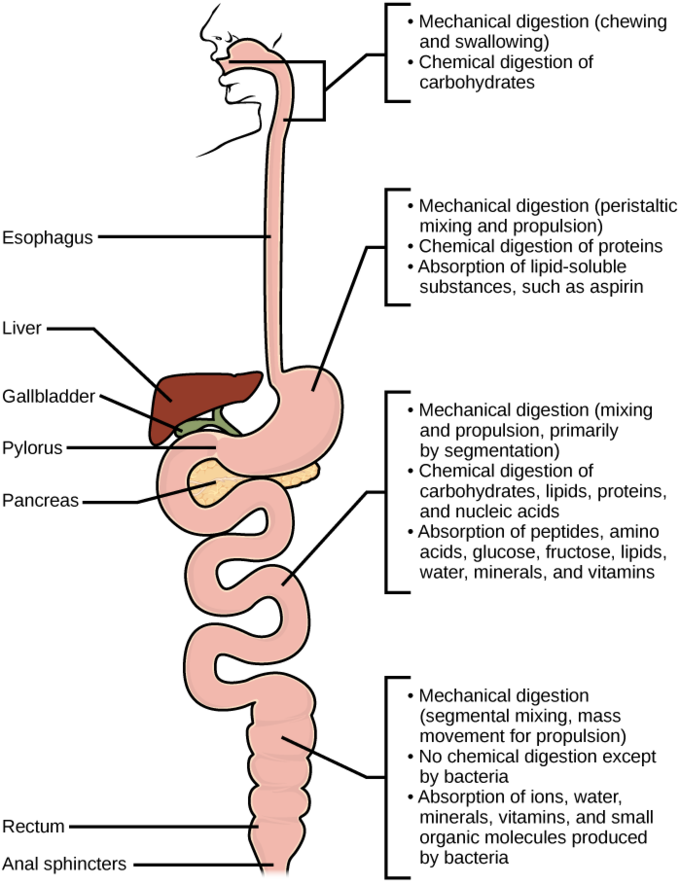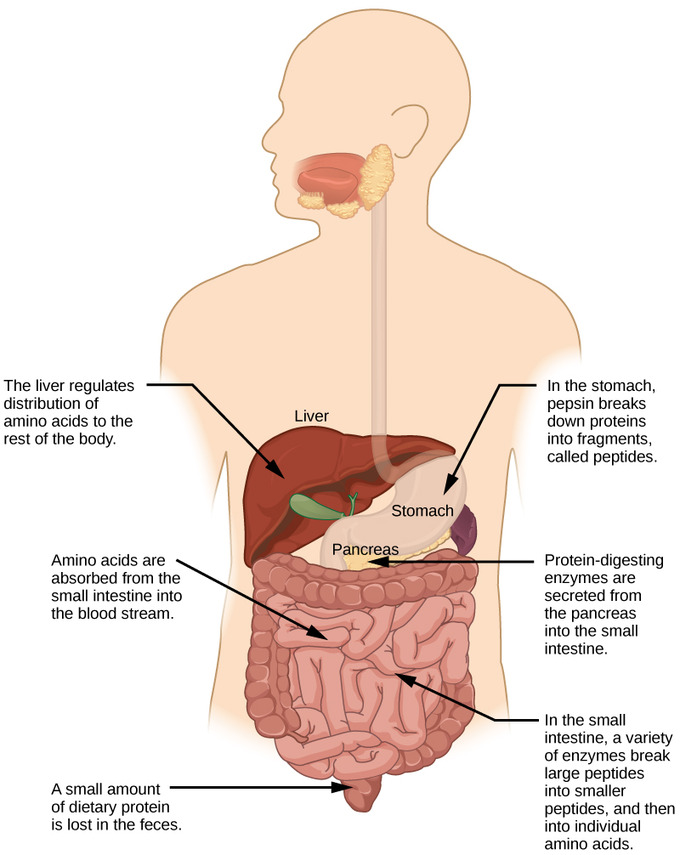34.10: Digestive System Processes - Digestion and Absorption
- Page ID
- 13851
- Explain the processes of digestion and absorption
Digestion and Absorption
Digestion is the mechanical and chemical break down of food into small organic fragments. Mechanical digestion refers to the physical breakdown of large pieces of food into smaller pieces which can subsequently be accessed by digestive enzymes. In chemical digestion, enzymes break down food into the small molecules the body can use.
It is important to break down macromolecules into smaller fragments that are of suitable size for absorption across cell membranes. Large, complex molecules of proteins, polysaccharides, and lipids must be reduced to simpler particles before they can be absorbed by the digestive epithelial cells. Different organs play specific roles in the digestive process. The animal diet needs carbohydrates, protein, and fat, as well as vitamins and inorganic components for nutritional balance.
Digestive enzymes are enzymes that break down polymeric macromolecules into their smaller building blocks, in order to facilitate their absorption by the body. Digestive enzymes are found in the digestive tracts of animals. Digestive enzymes are diverse and are found in the saliva secreted by the salivary glands, in the stomach secreted by cells lining the stomach, in the pancreatic juice secreted by pancreatic exocrine cells, and in the intestinal (small and large) secretions, or as part of the lining of the gastrointestinal tract.
Intestinal microflora benefit the host by gleaning the energy from the fermentation of undigested carbohydrates and the subsequent absorption of short-chain fatty acids. Intestinal bacteria also play a role in synthesizing vitamin B and vitamin K as well as metabolizing bile acids, sterols and xenobiotics.

Carbohydrates
The digestion of carbohydrates begins in the mouth. The salivary enzyme amylase begins the breakdown of food starches into maltose, a disaccharide. As the food travels through the esophagus to the stomach, no significant digestion of carbohydrates takes place. The acidic environment in the stomach stops amylase from continuing to break down the molecules.
The next step of carbohydrate digestion takes place in the duodenum. The chyme from the stomach enters the duodenum and mixes with the digestive secretions from the pancreas, liver, and gallbladder. Pancreatic juices also contain amylase, which continues the breakdown of starch and glycogen into maltose and other disaccharides. These disaccharides are then broken down into monosaccharides by enzymes called maltases, sucrases, and lactases. The monosaccharides produced are absorbed so that they can be used in metabolic pathways to harness energy. They are absorbed across the intestinal epithelium into the bloodstream to be transported to the different cells in the body.

Protein
A large part of protein digestion takes place in the stomach. The enzyme pepsin plays an important role in the digestion of proteins by breaking them down into peptides, short chains of four to nine amino acids. In the duodenum, other enzymes – trypsin, elastase, and chymotrypsin – act on the peptides, reducing them to smaller peptides. These enzymes are produced by the pancreas and released into the duodenum where they also act on the chyme. Further breakdown of peptides to single amino acids is aided by enzymes called peptidases (those that break down peptides). The amino acids are absorbed into the bloodstream through the small intestine.

Lipids
Lipid (fat) digestion begins in the stomach with the aid of lingual lipase and gastric lipase. However, the bulk of lipid digestion occurs in the small intestine due to pancreatic lipase. When chyme enters the duodenum, the hormonal responses trigger the release of bile, which is produced in the liver and stored in the gallbladder. Bile aids in the digestion of lipids, primarily triglycerides, through emulsification. Emulsification is a process in which large lipid globules are broken down into several small lipid globules. These small globules are widely distributed in the chyme rather than forming large aggregates. Lipids are hydrophobic substances. Bile contains bile salts, which have hydrophobic and hydrophilic sides. The bile salts’ hydrophilic side can interface with water, while the hydrophobic side interfaces with lipids, thereby emulsifying large lipid globules into small lipid globules.
Emulsification is important for the digestion of lipids because lipases can only efficiently act on the lipids when they are broken into small aggregates. Lipases break down the lipids into fatty acids and glycerides. These molecules can pass through the plasma membrane of the cell, entering the epithelial cells of the intestinal lining. The bile salts surround long-chain fatty acids and monoglycerides, forming tiny spheres called micelles. The micelles move into the brush border of the small intestine absorptive cells where the long-chain fatty acids and monoglycerides diffuse out of the micelles into the absorptive cells, leaving the micelles behind in the chyme. The long-chain fatty acids and monoglycerides recombine in the absorptive cells to form triglycerides, which aggregate into globules, and are then coated with proteins. These large spheres are called chylomicrons. Chylomicrons contain triglycerides, cholesterol, and other lipids; they have proteins on their surface. The surface is also composed of the hydrophilic phosphate “heads” of phospholipids. Together, they enable the chylomicron to move in an aqueous environment without exposing the lipids to water. Chylomicrons leave the absorptive cells via exocytosis, entering the lymphatic vessels. From there, they enter the blood in the subclavian vein.

Vitamins
Vitamins can be either water-soluble or lipid-soluble. Fat-soluble vitamins are absorbed in the same manner as lipids. It is important to consume some amount of dietary lipid to aid the absorption of lipid-soluble vitamins. Water-soluble vitamins can be directly absorbed into the bloodstream from the intestine.
Key Points
- In the mouth, carbohydrates are broken down by amylase into maltose (a disaccharide ) and then move down the esophagus, which produces mucus for lubrication, but no digestive enzymes.
- In the duodenum, disaccharides are broken down into monosaccharides by enzymes called maltases, sucrases, and lactases; the monosaccharides produced are then absorbed into the bloodstream and transported to cells to be used in metabolic pathways to harness energy.
- In the stomach, proteins are broken down into peptides, which are then broken down into single amino acids that are absorbed in the bloodstream though the small intestine.
- Lipids are digested mainly in the small intestine by bile salts through the process of emulsification, which allows lipases to divide lipids into fatty acids and monoglycerides.
- Monoglycerides and fatty acids enter absorptive cells in the small intestine through micelles; they leave micelles and recombine into chylomicrons, which then enter the bloodstream.
- Fat-soluble vitamins are absorbed in the same manner as lipids; water-soluble vitamins can be directly absorbed into the bloodstream from the intestine.
Key Terms
- chemical digestion: The process of enzymes breaking down food into small molecules the body can use.
- lipase: Enzymes in the pancreatic juices that break down lipids.
- chylomicron: A microscopic globule of triglycerids and other lipids coated with proteins, found in blood and lymphatic vessels, that is associated with the digestion of fats.
- amylase: Any of a class of digestive enzymes present in saliva that break down complex carbohydrates, such as starch, into simpler sugars like glucose.
- mechanical digestion: The physical breakdown of large pieces of food into smaller pieces which can subsequently be accessed by enzymes.


